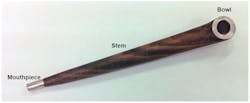Tobacco use in all its forms is one of the leading causes of preventable death. You may be familiar with dokha, a traditional tobacco common in some countries of the Middle East (e.g., the United Arab Emirates (UAE), Iran). Dokha is an Arabic word meaning vertigo. This article will focus on the prevalence, pattern, risks, and health effects of dokha use in the Middle East. Smoking rates (of tobacco of any kind) among men in the Arab world are amongst the highest around the globe.1.2
Figure 1: A midwakh, a pipe of Middle Eastern origin
Bedouins and sailors in the Arabian Peninsula, predominantly the Gulf area, customarily smoked dohka, a traditional tobacco which was formerly often mixed with herbs, spices, dried flowers, and fruit.3 Dokha tobacco has been smoked in the Middle East for over 500 years. Some dokha blends, especially Iranian and Turkish ones, were also mixed with the leaves and bark of various indigenous plants. Today, dokha is pure tobacco. It is smoked using a small pipe known as a midwakh (figure 1).3
Over the past decade, dokha smoking has become popular among Middle Eastern adolescents.4 A cross-sectional survey of male secondary school students in Ajman, United Arab Emirates, was conducted to measure the incidence of dokha smoking. A total of 560 participants completed self- administered questionnaires, and the prevalence was found to be high when compared to other forms of smoking in the region and globally.5 Prevalence increased with the age and grade of students; prevalence of never smokers, never dokha smokers, and current dokha smokers was lower in students of the sciences. 40% of the smokers used dokha, cigarettes, and shisha (i.e., molasses-based tobacco mixture smoked in a hookah), 30% used dokha and cigarettes, and 21% used dokha alone. 30% of the students smoked dokha on all days of the month.
Another study looked at the prevalence and pattern of dokha use among medical university students, again using a self-administered questionnaire.6 The prevalence of dokha smoking was higher among male participants, and the majority of dokha smokers (18.6%) were from the College of Allied Health Sciences. The conclusion was that dokha use is common in the young people in the sample, and anti-smoking programs for university students should be created. Many agree that there is a pressing need for specific health promotion programs tailored to this age group on prevention of dokha smoking and policies restricting the availability of dokha to this age group. Effective outreach health education programs, targeting adolescents, especially school students before they take up the habit of smoking, may therefore control the development of the problem.
Research has identified that midwakh is the second commonest form of tobacco use in the UAE.2 Although its use has historically been limited to the UAE and Qatar, there is anecdotal evidence that it is spreading. The very large expatriate populations in the Gulf may also increase the habit in other countries in the region and beyond, as was seen with the rapid spread of shisha smoking over the last 20 years. There is some evidence that it is slowly becoming more popular in the United States.7
Tobacco use has numerous, serious pathophysiological short- and long-term effects. The literature mainly reports the effects of tobacco through cigarette smoking, with a dearth of information on the effects of other forms of smoked tobacco. One study has demonstrated that dokha had similar acute effects on blood pressure and respiratory rate as other forms of smoking.6 Another showed that smoking dokha has a significant acute effect on systolic blood pressure, heart rate and respiratory rate.8 Further studies on the effect of dokha on the cardiorespiratory and other systems, especially compared with cigarette tobacco, are needed.
Editor's note: This content was originally published in 2015 and has been updated as of May 2025.
References
1. Smoking & tobacco use: Fast facts. Centers for Disease Control and Prevention website. http://www.cdc.gov/tobacco/data_statistics/fact_sheets/fast_facts/. Accessed March 10, 2015.
2. Al-Houqani M, Ali R, Hajat C. Tobacco smoking using Midwakh is an emerging health problem— evidence from a large cross-sectional survey in the United Arab Emirates [published online ahead of print June 15, 2012]. PLoS One. 2012. doi: 10.1371/journal.pone.0039189.
3. Lesson 1: What is dokha? Medwakh.com. http://www.medwakh.com/what-is-dokha. Accessed March 10, 2015.
4. John LJ, Muttappallymyalil J. Dokha: an emerging public health issue as a form of tobacco smoking in the Middle East. Asian Pac J Cancer Prev. 2013;14:7065-7.
5. Shemmari NA, Shaikh RB, Sreedharan J. Prevalence of dokha use among secondary school students in Ajman, United Arab Emirates. Asian Pac J Cancer Prev. 2015 ;16:427-30.
6. Jayakumary M, Jayadevan S, Ranade AV, Mathew E. Prevalence and pattern of dokha use among medical and allied health students in Ajman, United Arab Emirates. Asian Pac J Cancer Prev. 2010;11:1547-9.
7. Just when you thought you knew it all: More tobacco facts. Prevent the Sale website. http://www.preventthesale.com/idaho/pdf/Volume_7_2008/Vol_7_No_3.pdf. Published March 2008. Accessed March 10, 2015.
8. Shaikh RB, Abdul Haque NM, Hadi HA, et al. Acute effects of dokha smoking on the cardiovascular and respiratory systems among UAE male university students. Asian Pacific J Cancer Prev. 2012;13:1819-1822.
About the Author
Maria Perno Goldie, RDH, MS
Maria Perno Goldie, RDH, MS, was previously the editorial director of RDH eVillage FOCUS.


